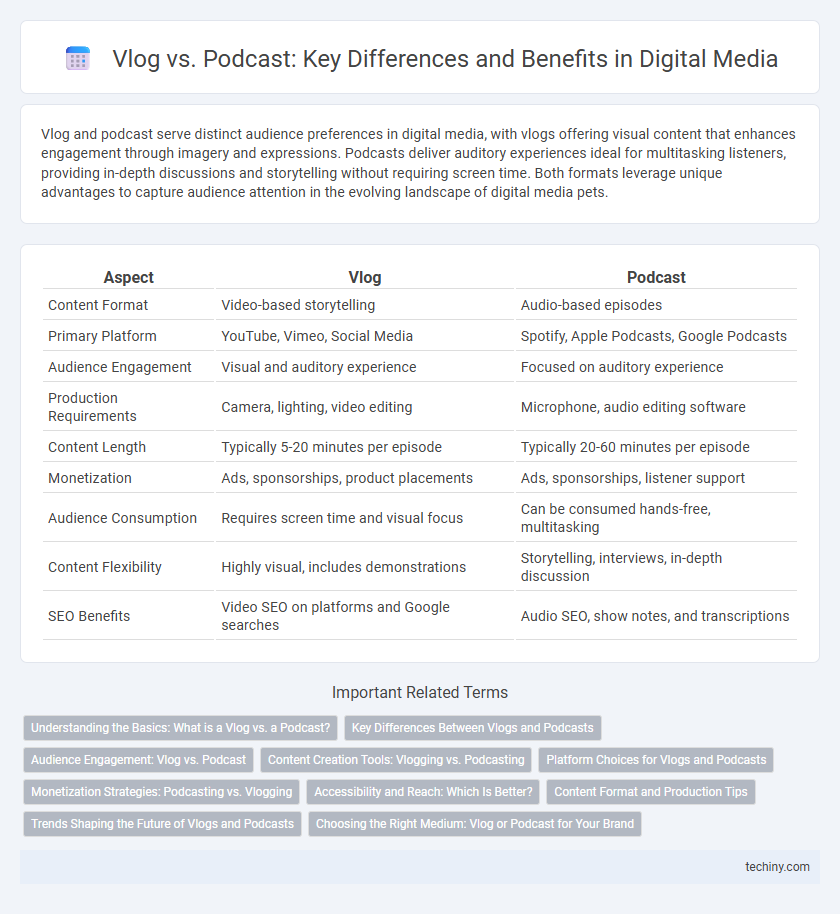Vlog and podcast serve distinct audience preferences in digital media, with vlogs offering visual content that enhances engagement through imagery and expressions. Podcasts deliver auditory experiences ideal for multitasking listeners, providing in-depth discussions and storytelling without requiring screen time. Both formats leverage unique advantages to capture audience attention in the evolving landscape of digital media pets.
Table of Comparison
| Aspect | Vlog | Podcast |
|---|---|---|
| Content Format | Video-based storytelling | Audio-based episodes |
| Primary Platform | YouTube, Vimeo, Social Media | Spotify, Apple Podcasts, Google Podcasts |
| Audience Engagement | Visual and auditory experience | Focused on auditory experience |
| Production Requirements | Camera, lighting, video editing | Microphone, audio editing software |
| Content Length | Typically 5-20 minutes per episode | Typically 20-60 minutes per episode |
| Monetization | Ads, sponsorships, product placements | Ads, sponsorships, listener support |
| Audience Consumption | Requires screen time and visual focus | Can be consumed hands-free, multitasking |
| Content Flexibility | Highly visual, includes demonstrations | Storytelling, interviews, in-depth discussion |
| SEO Benefits | Video SEO on platforms and Google searches | Audio SEO, show notes, and transcriptions |
Understanding the Basics: What is a Vlog vs. a Podcast?
A vlog, or video blog, primarily delivers content through video format, combining visuals and audio to engage viewers on platforms like YouTube. In contrast, a podcast distributes audio episodes focusing on storytelling, interviews, or discussions, accessible via platforms such as Spotify or Apple Podcasts. Understanding these core differences helps creators choose the right medium for audience engagement and content style in digital media.
Key Differences Between Vlogs and Podcasts
Vlogs primarily rely on visual content delivered through video platforms like YouTube, engaging audiences with dynamic imagery, facial expressions, and visual storytelling. Podcasts focus on audio content distributed via platforms such as Spotify and Apple Podcasts, allowing listeners to consume content hands-free during multitasking. Key differences include the medium used, production complexity, audience engagement methods, and content consumption habits, with vlogs requiring visual setup and podcasts emphasizing sound quality and dialogue.
Audience Engagement: Vlog vs. Podcast
Vlogs offer a visual and interactive experience that enhances audience engagement through dynamic visuals, facial expressions, and real-time reactions, appealing to viewers who prefer immersive content. Podcasts engage listeners with in-depth storytelling and intimate audio connections, allowing multitasking and fostering a loyal community through consistent, topic-focused episodes. Both formats leverage unique sensory channels to create strong emotional bonds, but vlogs cater more to visual learners while podcasts excel with auditory audiences.
Content Creation Tools: Vlogging vs. Podcasting
Vlogging relies on video cameras, smartphones, and editing software such as Adobe Premiere Pro or Final Cut Pro to produce visually engaging content. Podcasting primarily uses high-quality microphones, audio interfaces, and software like Audacity or GarageBand to capture and edit clear audio narratives. Both content creation tools cater to distinct formats, influencing workflow, equipment investment, and audience engagement strategies in digital media production.
Platform Choices for Vlogs and Podcasts
YouTube remains the dominant platform for vlogs, offering extensive reach and monetization options for video creators. Podcasts thrive on platforms like Spotify, Apple Podcasts, and Google Podcasts, which provide targeted audience segmentation and seamless audio streaming. Selecting the right platform depends on content format, audience preferences, and discoverability features unique to each medium.
Monetization Strategies: Podcasting vs. Vlogging
Podcast monetization strategies often revolve around sponsorship deals, listener donations through platforms like Patreon, and dynamic ad insertion tailored to audience demographics. Vloggers typically generate revenue via YouTube AdSense, brand collaborations, affiliate marketing, and merchandise sales directly linked to their visual content. Both formats benefit from leveraging niche audiences, but podcasts often achieve higher ROI through targeted audio ads, while vlogs capitalize on visual engagement for diversified income streams.
Accessibility and Reach: Which Is Better?
Vlogs offer visual engagement, making content more accessible to viewers who prefer visual learning and providing opportunities for branding through imagery. Podcasts enhance reach through audio-only formats, allowing audiences to consume content hands-free during commutes or multitasking, appealing to listeners with limited screen time. Both mediums expand accessibility differently; vlogs leverage visual platforms like YouTube, while podcasts capitalize on audio distribution across Spotify and Apple Podcasts for broader audience penetration.
Content Format and Production Tips
Vlogs utilize visual storytelling through video footage, making them ideal for demonstrating tutorials and capturing dynamic environments, while podcasts rely on audio content suited for in-depth discussions and storytelling. Effective vlog production requires high-quality cameras, lighting, and editing software to enhance visual engagement, whereas podcast creation prioritizes clear audio capture using professional microphones and soundproofing techniques. Both formats benefit from consistent release schedules and targeted content planning to maximize audience retention and platform algorithms.
Trends Shaping the Future of Vlogs and Podcasts
Vlogs increasingly integrate immersive technologies such as augmented reality and 360-degree video to create engaging, interactive viewer experiences. Podcasts leverage AI-driven personalization and voice search optimization, enhancing discoverability and listener retention across platforms like Spotify and Apple Podcasts. Both formats are evolving through cross-platform distribution and influencer collaborations, driving dynamic content consumption trends in digital media.
Choosing the Right Medium: Vlog or Podcast for Your Brand
Selecting the right medium between vlog and podcast depends on your brand's content style, target audience, and engagement goals. Vlogs excel in visual storytelling and brand personality expression, ideal for products requiring demonstrations or lifestyle appeal, while podcasts offer deeper audio-driven content perfect for thought leadership and long-form discussions. Analyze your audience's consumption habits and the resources available to produce consistent, high-quality content that aligns with your brand identity and marketing objectives.
Vlog vs Podcast Infographic

 techiny.com
techiny.com